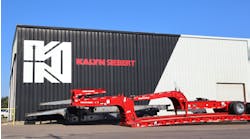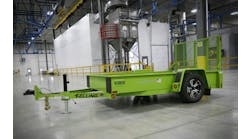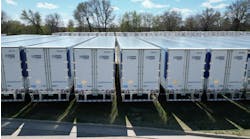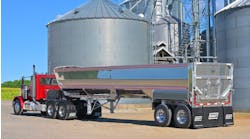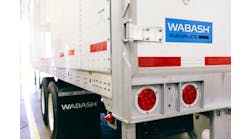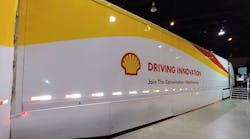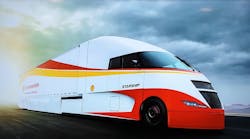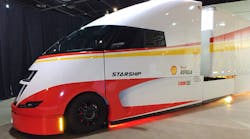It’s easy to fixate on the front of Shell’s Starship.
From the active grill shutters on the nose of the truck’s futuristic, carbon-fiber body to the custom DOT-approved, wrap-around windshield and tech-filled cab, the tractor is an awesome sight to behold.
But don’t forget about that 53-foot trailer attached to the back of the concept truck.
In fact, when considering the Starship’s potential for freight-ton efficiency, it’s best not to start at the beginning.
“Trailers are more important, fuel efficiency-wise, than a tractor is, all things considered,” said Bob Sliwa, who drove the concept truck that his AirFlow Truck Company partnered with Shell to design and build. “The rear of any vehicle is more important aerodynamically than the front of any vehicle.”
That might seem counterintuitive, since the tractor’s slicing through the air, pulling the trailer behind, but the shape of any vehicle’s rear end greatly impacts lift and drag – thus the emergence of trailer tails – and then there are the trailer’s added weight, pesky air gaps and rolling resistance.
And this being a Starship, its trailer also features a solar array, so this trailer has a tail – and a tale to tell.
Soaking up the sun
Strick Trailers built the light-weight dry van trailer, which weighed 10,900 pounds before modifications, using aluminum cross members, bows and – perhaps most importantly for long-term weight savings – flooring.
“Normally, they’ll put a hardwood floor inside a trailer, and that’s alright to start with, but then the humidity sinks into the wood, and it loads up with water and gets heavier and heavier,” Sliwa said.
AirFlow added pneumatic landing gear controlled by buttons on the side of the trailer, eliminating the need for a bulky crank hand or the recessed hole, which isn’t aerodynamic, to store it in.
Then they added a 5,000-watt solar array to the trailer’s roof.
The solar cells are a thin, flexible membrane with adhesive on one side that attach like “putting sideways wallpaper on,” so the whole array, which includes 15 solar panels, only adds about 300 pounds, Sliwa said.
The panels are tied into five solar strings, and the three panels in each string are wired in series to produce 88 to 90 volts. The solar strings are run in parallel to the trailer bulkhead, where the charge controllers are located.
“They’ve got five different circuit breakers going into there, and then they go into dual Morningstar charge controllers, into dual buses, and then we come back out and it drops it down to 58.8 volts,” Sliwa said.
“The highest by law you can go outside the trailer with is 60 volts, because we don’t want to have a truck driver plug the thing in, in the rain, and get electrocuted.”
The solar array powers the dual 48-volt air conditioning systems in the tractor, even when the truck is shut off and parked at a truck stop or rest area, so the cab – and Sliwa’s dog – stay nice and cool.
Skirting the issue
The trailer’s most noticeable feature – and some say least practical – are the skirts stretching from the tractor’s rear wheels to the trailer doors, with tire access hatches over each tandem axle to reach Goodyear’s resistance-reducing Bandag B135 FuelTech wide-base retreads on Bridgestone Greatec casings.
Those full-length skirts are only three inches off the ground in the front section.
Sliwa says he’s heard a working tractor-trailer “couldn’t go around the block without them ripping off,” but he disagrees, and to his point, his skirts made it from California to Florida fully intact.
“They’re almost impervious,” he said. “As low as they look, they’re made to bend out of the way.”
That’s because, unlike the carbon-fiber body, the skirts and supporting struts are made from a durable yet flexible composite material.
“Each of the two bolts in the center of the skirts have a strut behind them, and those struts literally can bend like a ‘U,’ so the bottom of the skirt is facing upward,” Sliwa said. “So, if you go over a railroad track, they bend out of the way, and when you go past the track – ‘boing,’ they go back down.”
The skirts also boast the added benefit of providing increased stability, a feature that came in handy while the Starship was navigating 75 mph crosswinds in Utah.
“A lot of people think it’s the opposite, and if you have full skirts it’s going to cause (the trailer) to tip more,” Sliwa said. “No, because (the wind’s) going to hit at the bottom, too, and counteract the weight where it wants to tip over.”
Extra tall tails
STEMCO’s modified, manually deployed trailer tails bring up the rear.
With help from STEMCO’s engineering team, the tails flow from roof to skirt, taking advantage of an exemption STEMCO received from the Federal Motor Carrier Safety Administration in February allowing rear ID lights and clearance lamps to be mounted lower than currently stipulated by regulations.
“Normally, the trailer tails terminate above the lights on the rear of the truck,” Sliwa said. “But when I had this trailer built, I did not have them cut the round, 4-inch holes inside the frame, so there are no lights back there.
“So, we could flush mount DOT-legal Fontaine trailer lights inside the rear impact protection bar, and we Frenched those in after we cut them out by hand.
“That way people can see the lights even on the side of the truck, without being obscured.”
AirFlow also added composite fairings that divert air over the top of the door frame after computational fluid dynamics (CFD) software revealed the area’s negative impact on the trailer’s aerodynamics.
“When we saw it in CFD that thing showed up like a sore thumb,” Sliwa said.

